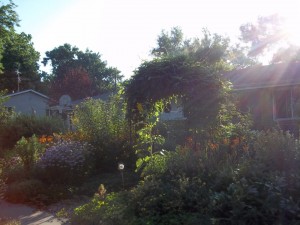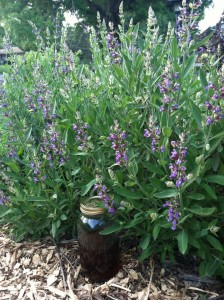
Sage reminds me of my centenarian spinster great aunt who was one of the first women rural mail carriers and traveled the world. She was not a striking beauty, but she was incredibly interesting and did not wilt when times got tough. There are many salvia/sages all with interesting stories, but my favorite is the Salvia officinalis, also called common garden or kitchen sage. I grow the broad leaf and narrow leaf sage. Their grey green leaves are a welcome contrast in the garden. Sage is a knee-high woody perennial that grows in zones 4-9. All sage requires is a sunny spot with well drained soil.
Sage was used medicinally long before it flavored our meals. There was a medieval saying, “Why should a man die while sage grows in his garden?” Even more fascinating, sage was an ingredient in the legendary thieves vinegar that protected those robbing the bodies stricken with the bubonic plague/black death in the middle ages.
Sage does it all~it is an astringent, anti inflammatory, lowers blood sugars, calms asthma and sooths insect bites for starters. Sage enhances memory, and is being looked at to help Alzheimer patients. Since sage is an estrogenic it also helps alleviate hot flashes (note~if you have an estrogen receptive cancer you should talk to your doctor before you take sage). Sage will reduces milk production in nursing mothers, which can be bad or good depending on what stage of nursing you find yourself. Pregnant women should not eat sage. However, the ancient Egyptians thought sage increase fertility.

If you Google sage recipes you will find enough recipes to try one every day for the rest of the year. Because sage helps with digestion it is often paired with fatty meats such as sausage, pork or goose. My favorite culinary use of sage is chopped up and added to quark. Try putting a leaf between the meat and veggies on your kabob or sprinkling dried sage on your hot popcorn.
With such an early spring this year my sage is already blooming. Sage flowers are lovely blue with a slightly milder taste than the leaves. My friend, who works at a daycare that encourages the kids to explore nature, says the kids especially like to eat the sage flowers.
Sage can be propagated by seed, cutting or by taking a branch and pinning it to the ground and waiting for it to root. As with all herbs, you should pick them in the morning after the dew dries for the best flavor. To dry sage, hang the leaves on the stem in small bunches upside down in a warm, dry, well ventilated place. Once the leaves are dry take them off the stems and store them in a jar in a cool, dark, dry place.
Happy May Day~add some sage to your may baskets and enjoy the day we learn to give without receiving~


